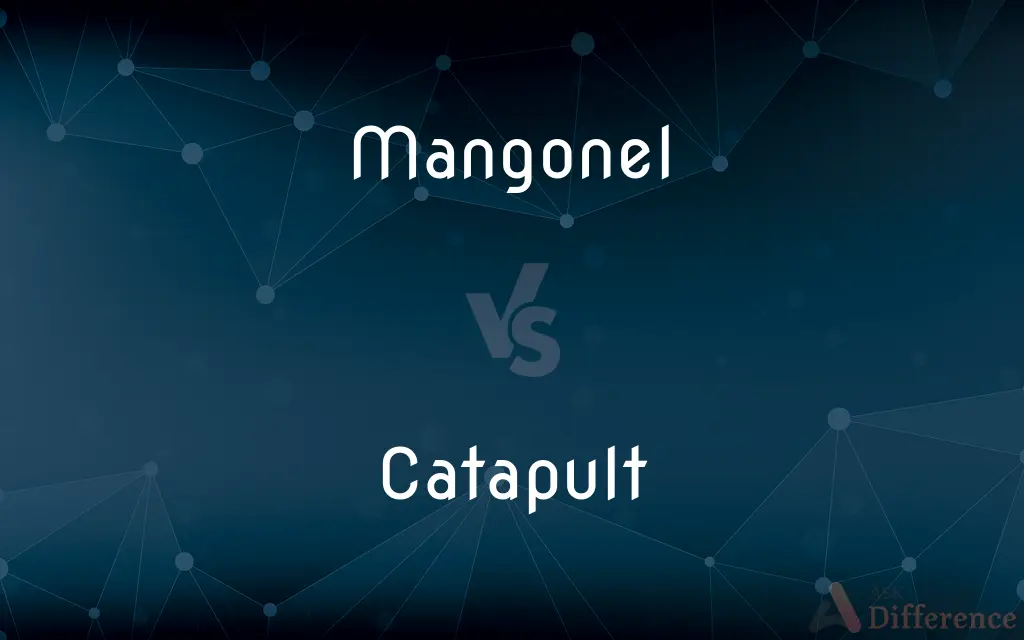Mangonel vs. Catapult — What's the Difference?
Edited by Tayyaba Rehman — By Urooj Arif — Updated on March 28, 2024
A mangonel launches projectiles with a sling mechanism for medium range, focusing on arc trajectories, whereas a catapult, often a broader category, can include various mechanisms like torsion for varied ranges.

Difference Between Mangonel and Catapult
Table of Contents
ADVERTISEMENT
Key Differences
Mangonels are a type of medieval siege engine designed to hurl stones or other projectiles over walls or into fortresses, primarily using a sling mechanism. This design allows for a high arc of fire, making it effective for attacking fortifications from a distance. On the other hand, catapults encompass a wider range of siege engines, including mangonels, trebuchets, and onagers, that use tension, torsion, or counterweight mechanisms to launch projectiles. The term "catapult" is more generic and can refer to devices that achieve both direct and indirect fire.
The mangonel’s operation involves pulling down a wooden arm with a sling attached, which, when released, flings the projectile towards its target. This method primarily relies on manpower or mechanical force for tension. Whereas, catapults, depending on their specific type, might use twisted ropes (torsion), a counterweight (trebuchet), or other mechanisms to launch projectiles, offering different ranges and tactical advantages.
Historically, mangonels were widely used in the medieval period for their simplicity and effectiveness in siege warfare. They were especially favored for their ability to launch projectiles at high arcs, bypassing defensive walls. Catapults, in their broader categorization, have been used since ancient times, evolving through centuries to include a variety of designs each suited to specific military needs, from breaching fortifications to delivering incendiary payloads.
In terms of construction, mangonels tend to be simpler and more straightforward to build compared to some of the more complex catapult designs, such as the trebuchet. This simplicity made them accessible for various military forces, whereas more sophisticated catapults like trebuchets required greater resources and engineering knowledge.
Mangonels and catapults, while both serving as siege engines, have distinct characteristics in terms of range, projectile trajectory, and historical usage. The mangonel's use of a sling for launching projectiles gives it a unique place in the category of catapults, demonstrating the diversity of medieval siege technology and tactics.
ADVERTISEMENT
Comparison Chart
Mechanism
Sling mechanism
Various (torsion, tension, counterweight)
Trajectory
High arc, suitable for lobbing over walls
Varies, can achieve direct or indirect fire
Historical Use
Medieval period for sieges
Since ancient times, evolved over centuries
Construction
Simpler, less resource-intensive
Ranges from simple to complex
Tactical Use
Effective against fortifications
Versatile, used for breaching and bombardment
Compare with Definitions
Mangonel
A medieval siege weapon using a sling.
The mangonel hurled stones over the castle walls.
Catapult
Can utilize various launching mechanisms.
The catapult's torsion design allowed for powerful launches.
Mangonel
Simpler siege engine construction.
The army could quickly assemble a mangonel with available materials.
Catapult
A broad category of siege engines.
The ancient army used a catapult to attack the city.
Mangonel
Designed for high-arc projectiles.
The mangonel's design was perfect for attacking enemies behind fortifications.
Catapult
Versatile in military tactics.
The commander used a catapult to launch both stones and fire pots.
Mangonel
Operates with tension mechanism.
Soldiers pulled the mangonel's arm down to launch projectiles.
Catapult
Suitable for different ranges and trajectories.
Engineers adjusted the catapult for maximum range.
Mangonel
Effective in breaching defenses.
The mangonel was crucial in the siege, breaking the fortress walls.
Catapult
Evolved through history for siege warfare.
The catapult design has been refined over centuries of conflict.
Mangonel
The mangonel, also called the traction trebuchet, was a type of trebuchet used in Ancient China starting from the Warring States period, and later across Eurasia by the 6th century AD. Unlike the later counterweight trebuchet, the mangonel operated on manpower pulling cords attached to a lever and sling to launch projectiles.Although the mangonel required more men to function, it was also less complex and faster to reload than the torsion-powered onager which it replaced in early Medieval Europe. It was replaced as the primary siege weapon in the 12th and 13th centuries by the counterweight trebuchet.
Catapult
A catapult is a ballistic device used to launch a projectile a great distance without the aid of gunpowder or other propellants – particularly various types of ancient and medieval siege engines. A catapult uses the sudden release of stored potential energy to propel its payload.
Mangonel
A military machine used during the Middle Ages for hurling stones and other missiles, often employing a wooden arm with a container at one end.
Catapult
Any of various military machines used for hurling missiles, such as large stones or spears, in ancient and medieval times.
Mangonel
(historical) A military engine formerly used for throwing stones and burning objects.
Catapult
A mechanism for launching aircraft at a speed sufficient for flight, as from the deck of a carrier.
Mangonel
A traction trebuchet trebuchet operated by manpower.
Catapult
A slingshot.
Mangonel
An onager type of catapult.
Catapult
To hurl or launch from a catapult.
Mangonel
A military engine formerly used for throwing stones and javelins.
Catapult
To hurl or launch by means other than a catapult
The blast catapulted bricks across the street.
Mangonel
Medieval artillery used during sieges; a heavy war engine for hurling large stones and other missiles
Catapult
To bring suddenly into prominence
The film catapulted her into fame.
Catapult
To be catapulted or hurled
The rider catapulted over the handlebars.
Catapult
To jump or spring
She catapulted over the gate.
Catapult
A device or weapon for throwing or launching large objects.
Catapult
A mechanical aid on aircraft carriers designed to help airplanes take off from the flight deck.
Catapult
(UK) A slingshot.
Catapult
An instance of firing a missile from a catapult.
Catapult
(figuratively) An instance of firing something, as if from a catapult.
Catapult
(transitive) To fire a missile from a catapult.
Catapult
(transitive) To fire or launch something, as if from a catapult.
Catapult
(transitive) To increase the status of something rapidly.
The candidate selection for running mate has catapulted her to the national scene.
Catapult
(intransitive) To be fired from a catapult or as if from a catapult.
Catapult
(intransitive) To have one's status increased rapidly.
She catapulted to the national scene following her selection by the candidate.
Catapult
An engine somewhat resembling a massive crossbow, used by the ancient Greeks and Romans for throwing stones, arrows, spears, etc.
Catapult
A forked stick with elastic band for throwing small stones, etc.
Catapult
A plaything consisting of a Y-shaped stick with elastic between the arms; used to propel small stones
Catapult
A device that launches aircraft from a warship
Catapult
Medieval artillery used during sieges; a heavy war engine for hurling large stones and other missiles
Catapult
Shoot forth or launch, as if from a catapult;
The enemy catapulted rocks towards the fort
Catapult
Hurl as if with a sling
Common Curiosities
How does the projectile trajectory of a mangonel compare to other catapults?
Mangonels typically have a higher arc trajectory, ideal for lobbing projectiles over walls.
Why were mangonels favored in medieval warfare?
Their simplicity, effectiveness at sieging fortifications, and high-arc projectile launch made them favored.
What distinguishes a mangonel from other catapults?
A mangonel specifically uses a sling mechanism for launching projectiles, typically at a high arc.
Can a mangonel be considered a type of catapult?
Yes, a mangonel is a type of catapult, focusing on sling-based launching mechanisms.
What are the main uses of catapults in siege warfare?
Catapults are used to breach fortifications, deliver incendiary devices, and bombard enemy positions.
What factors influenced the development of different types of catapults?
Tactical needs, technological advancements, and specific challenges of siege warfare influenced their development.
How did siege tactics evolve with the development of catapult technology?
Siege tactics evolved to incorporate the range, power, and versatility of different catapult designs, leading to more strategic sieges.
Do all catapults use the same mechanism as mangonels?
No, catapults can use various mechanisms, including torsion, tension, and counterweight, unlike the specific sling mechanism of mangonels.
What type of projectiles did mangonels typically launch?
Mangonels typically launched stones, but could also be used for incendiary devices and other projectiles.
Are replicas of mangonels and catapults used for educational purposes today?
Yes, replicas are often constructed for historical demonstrations, education, and engineering analysis.
How did the construction complexity of catapults vary?
Construction complexity ranged from the relatively simple mangonel to more sophisticated designs like the trebuchet.
Were catapults used outside of siege contexts?
While primarily siege engines, catapults were sometimes used in field battles and for defensive purposes.
What materials were used to build mangonels and other catapults?
Wood, rope, and metal were common materials, with design specifics varying by the type of catapult.
How has modern technology changed the understanding of ancient catapults?
Archaeology and reconstruction experiments have deepened understanding of their design, use, and effectiveness.
Did the use of catapults decline with the advent of gunpowder?
Yes, the development of cannon and gunpowder artillery gradually replaced catapults in military use.
Share Your Discovery

Previous Comparison
Capricious vs. Mercurial
Next Comparison
Kernel vs. StoneAuthor Spotlight
Written by
Urooj ArifUrooj is a skilled content writer at Ask Difference, known for her exceptional ability to simplify complex topics into engaging and informative content. With a passion for research and a flair for clear, concise writing, she consistently delivers articles that resonate with our diverse audience.
Edited by
Tayyaba RehmanTayyaba Rehman is a distinguished writer, currently serving as a primary contributor to askdifference.com. As a researcher in semantics and etymology, Tayyaba's passion for the complexity of languages and their distinctions has found a perfect home on the platform. Tayyaba delves into the intricacies of language, distinguishing between commonly confused words and phrases, thereby providing clarity for readers worldwide.














































